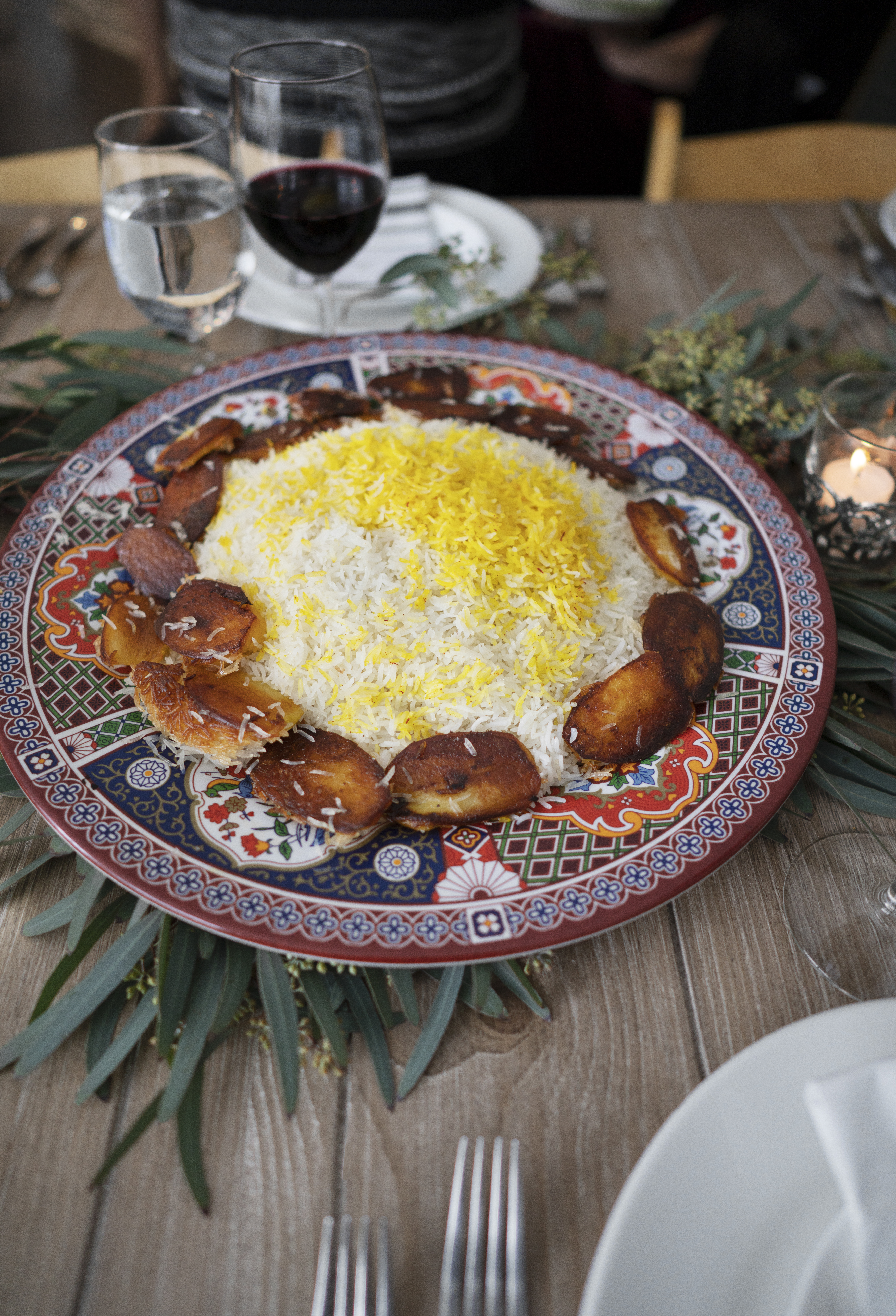
The first time I tried basmati rice with potato tahdig I absolutely adored it. Tahdig forms at the bottom of a pot by using, potatoes, pita bread, milk or yogurt and topped with rice to create a hard crust that captures the flavor during the cooking process. This recipe uses thin slices of potatoes to create a crispy, crunchy, golden tahdig.
A traditional Persian meal typically includes basmati rice, kabobs, Maast o khiar, torshi,and salad shirazi. You can also find each of these authentic Persian recipes in my cookbook, It Begins at the Table, available for sale in early September
In the Iranian culture,tahdig is everyone’s favorite part of the rice. There is a charming tradition of friendly fighting over the tahdig to see who gets the last piece. It’s just that good!
As they say in Persian,
“رمز عبور ته دیگ لطفا!” Pass the tahdig please!
Find more delicious Persian recipes below:
I hope you enjoy this recipe! If you’ve made it please share it with me by tagging @culinarybutterfly on Pinterest.
Share this Post
| Servings |
people
|
- 4 cups basmati rice, rinsed and soaked
- 4-8 tablespoons light olive oil
- 1/2 cup milk
- 1-2 medium yukon potatoes, sliced 1/4-inch thick rounds
- 2 tablespoons cold butter, cut into small pieces
- 2 teaspoons saffron water, or a pinch of saffron threads disolved in hot water
- 1 tablespoon plus 2 teaspoons salt, divided
Ingredients
|
|
- Place the rice in a medium bowl and rinse under cold water 4 to 5 times to remove dirt and debris until the water runs clear. Top the rice with 6 cups of water and 1 tablespoon of salt. Soak for 2 hours to 24 hours.
- Fill a large non-stick pot with 10 cups of water and bring to a boil on high heat. Add the drained rice and 1 teaspoon of salt to the water. Parboil the rice for 6 to 8 minutes or just until the rice is slightly soft on the outside grain. You can test this by biting into a grain. Pour the rice into a mesh strainer and rinse with cold water to stop the cooking process.

- Heat the oil in the same pot over medium heat, adjusting the amount of oil used depending on your pot size. The oil should be approximately 1/8-inch from the bottom. Stir in the milk. Cover the bottom of the pot with potato slices. Sprinkle the potatoes with remaining 1 teaspoon of salt.

- Spoon a thin layer of rice over the potatoes. Continue to add rice in layers by spooning the rice into the middle of the pot in a pyramid shape, allowing the rice to fall towards the sides. Poke 5 to 6 holes into the rice using the end of a wooden spoon at the center and around the rice. Add the butter pieces over the rice evenly.

- Mix 1/4 cup oil with 1/4 cup water and gently pour over the rice, being careful not to collapse the pyramid shape. Spoon the saffron water over the rice in a circular direction to create a spiral pattern. Reduce the heat to low.

- Cover the lid of the pot with a cotton tea towel, tying the ends at the top of the lid. Cover the pot with the lid, reduce the heat to low and steam the rice for 30 to 70 minutes (depending on your cooktop), checking to ensure it doesn’t burn.

- Remove the pot from the heat and rest it on a cool damp cloth to naturally loosen the tahdig from the pot. You can keep the rice in the pot until you are ready to serve it.
- To plate the rice, remove the cover from the pot, using a plate large enough to cover top of the pot, quickly invert the two together, allowing the rice and tahdig to loosen onto the plate. Serve the rice topped with the potato tahdig or cut it into wedges, setting the tahdig on the sides of the rice to serve. Serve hot with kabobs and a salad.

Recipe Notes:
- It is important that you use a non-stick pot for this recipe to prevent potatoes from sticking to the bottom.
- The amount of potatoes and salt needed will depend on the size of your pot. Sprinkle enough salt to lightly cover the potatoes.
- The potatoes should completely cover the bottom of the pot without overlapping.
- Be sure to cook on low to prevent potatoes from burning.

Comments
Luv the recipe, look forward to creating it in my kitchen! I also am finding the pictures such a helpful way to follow a recipe… especially the tricks that one does not alway notice with words… where images are so much more helpful! ;D
Thank you, Laurie! Glad the photos are helpful. Post your photos when you make it. I would love to see the end result!
My Family Loved it. I am definitely sharing Guys, Thanks For sharing this Great Recipe. this recipe and this website with my friend. Hope they also love it. Thank you again for sharing such a great recipe.
I am so happy you loved the Basmati Rice with Potato Tahdig! It’s a staple in Persian Cuisine and my family enjoys it as often as we can, too! You might like to try it with my Koofteh Persian Meatball recipe the next time you make it. It’s the number one recipe made from my blog! https://culinarybutterfly.com/recipe/koofteh-persian-meatballs/ Enjoy!
Lisa~